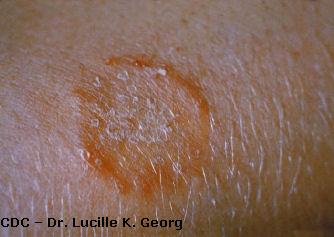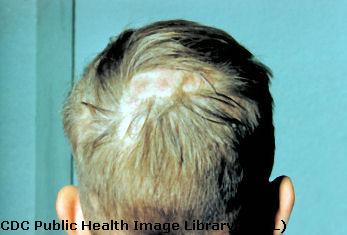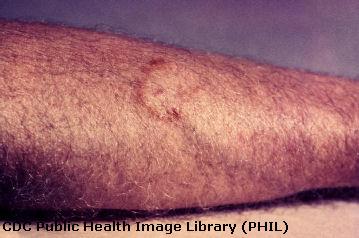Fungal Skin Infection: Ringworm (Tinea)
What is ringworm?
Ringworm is a common, contagious skin infection. Ringworm is NOT caused by a worm. A type of fungus called a dermatophyte causes it. Dermatophytes also cause other common skin, hair, and nail infections, including athlete's foot and jock itch.
 |
| Close-up of ringworm patch |
How does ringworm spread?
The dermatophyte that causes ringworm can be passed from person to person by direct skin-to-skin contact or by contact with contaminated items such as combs, unwashed clothing, and shower surfaces. Some pets (including cats and dogs) and livestock (such as cows, goats, horses, and pigs) can carry the fungus and transmit it to people. Because dermatophytes thrive in warm, moist areas, athletes are at risk for ringworm because they are likely to sweat and be around others who are sweating. This is why prevention is so important.
What are the symptoms of ringworm?
- Itchy, red, raised, scaly patches that may blister and ooze.
- Sharply-defined edges in the shape of a circle or a ring.
- Often redder around the outside with normal skin tone in the center.
- Skin may appear unusually dark or light.
- Bald patches on scalp.
- Finger and toenails that are discolored, thick, or crumble.
 |
| Ringworm on scalp |
How is ringworm diagnosed?
Medical professionals have several ways to determine if you have ringworm. They can:
- Diagnose it based on how the rash or affected area looks.
- Examine your skin in a dark room with a special blue light (called a Wood's lamp) that uses ultraviolet light to look for changes in your skin color.
- Scrape some of the affected area from your skin and examine the cells under a microscope.
 |
| Ringworm on arm |
How is ringworm treated?
Athletes with rashes should contact their doctor. If a doctor diagnoses the rash as ringworm, they may prescribe a fungicidal material to swallow as tablets or powders that can be applied directly to the affected areas.